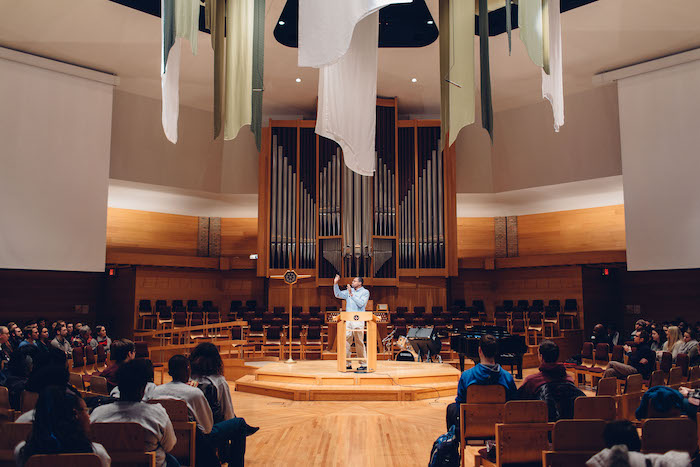Space to Thrive

The main entrance to Hekman Library, home to circulation and reference services, is now on the 300-level (above).
Mid-Century Architecture Meets Twenty-First Century Learning
Executive vice president for student experience and strategy Sarah Visser remembers the many hours she spent as a Calvin student at the Hekman Library in the late ’90s and early aughts, combing the stacks or seeking out a quiet study carrel on the more secluded fifth floor. She says today’s Calvin students still seek those quiet spaces, but they also see libraries a bit differently than she did—more as gathering places for cooperative learning.
Two changes can account for that shift: coursework has become more collaborative and project-based, and students can access many books and digital research tools online. Visser says Calvin began discussing renovations to Hekman Library that better met evolving modes of learning and student needs back in 2015, with a vision to create
“We wanted the library to be a place that fosters student engagement in the learning process,” Visser says. “We didn’t need to keep seven copies of the same book or shelve decades of academic journals. Though students still need access to print resources, increased access to digital resources suggested the physical space of the library was ripe for strategic redevelopment.”
Commons Union: A Project in Two Phases
Conversations about better stewarding campus space to nurture deeper community engagement go back at least two decades to a plan to redesign the Commons Dining Hall and Commons Annex—a vision that has not yet come to fruition. But the opening of the redesigned Hekman Library marks the completion of phase one of a revised plan known as Commons Union, a project designed in two phases tied closely to the original.
Though the architectural plans have changed, the why behind them remains the same: to invest in physical upgrades at Calvin is to invest in a dynamic campus ecosystem that supports learning and strengthens community. It’s about making room for all to thrive.
The Changing Face of Calvin
“A commons that serves all of our learners is really important. We’ve always talked about how a core way students learn is in com- munity and in these formational, relational ways. And it’s increasingly important as our student body diversifies,” Visser says.
Summer youth camps, dual enrollment for high school students, graduate and certificate programs, and the newly revamped Life and Career Studies program for students with intellectual disabilities have changed the composition of the Calvin student body in exciting ways. “When we think about our students as learners, we’re thinking about designing spaces on campus that enrich learning, connection, and collab- oration at every age and level. It’s a lifespan approach,” Visser says.
Community Reception
Director of Calvin’s Service-Learning Center and alumna Annie Mas-Smith ’06 remembers serving as a student leader when student organizations lived in the Commons Annex, a long, narrow building that felt more like a hallway than a welcoming student center. Relocating student organizations and services to a more central location on campus increases their visibility and accessibility. “To now be at the hub of the community and all its activity is so ex- citing,” Mas-Smith says of her new space on the 200-level of the redesigned library now known as Commons Union.
Student leader and office intern for Campus Ministries Anna Bierma agrees. “I’m from Alaska—I didn’t know anyone when I first came to Calvin. My first year, places like Peet’s or the library created points of contact where I caught up with new friends, worked on projects with classmates, and became involved with activities on cam- pus. The new library space will cultivate intentional social, academic, and spiritual community,” Bierma says.
That’s exactly the kind of feedback Visser loves to hear. With 40% of students living off campus, Visser has long believed the Calvin community needs a “family room”— a shared space where students, faculty, and visitors can gather, rest, learn, and study. The near-instant popularity of adding Peet’s Coffee on the 200-level of Hekman five years ago only solidified her commitment to ushering that dream toward its current reality.
Moving Forward
Visitors to campus can now enjoy the completion of phase one of the Commons Union, which includes a complete renovation of the library’s first three levels. Student organizations and key offices that serve students have relocated from Commons Annex to the 200-levels of Hekman and Hiemenga Hall, now connected by an interior tunnel. Adjacent to the new offices, the ever-popular Peet’s Coffee (top right) opens to an outdoor courtyard and fireplace. Visser thinks of this floor as “a space where everybody—students, alumni, visitors—can come hang out, meet, or work.”
The main entrance to Hekman Library, home to circulation and reference services, is now on the 300-level. Calvin Information Technology occupies the 100-level, alongside a new high-density book storage room and a student gathering and performance space.
Fundraising for phase two of Commons Union continues, and once completed, will support the construction of a consolidated dining hall with meeting spaces, retail offerings, and a “great hall” that will continue to advance the university’s vision to foster and support authentic community.






